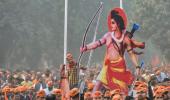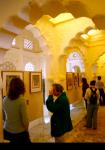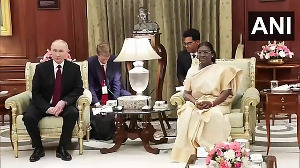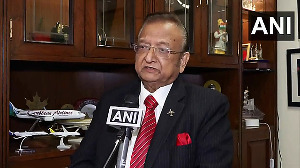'It has the potential to sow seeds of furthering discord when the direction of the discourse is aimed at propagating the perceived supremacy of 'cultural nationalism' from a distant past over the prevailing dominance of 'Constitutional nationalism',' argues N Sathiya Moorthy.

Rarely do institutions like the Archaeological Survey of India (ASI) get caught in what otherwise is a socio-political dispute.
But this one emanating from Tamil Nadu has combined academic contestations about the civilisational antiquity of different regions of the country and contemporary socio-political contextualisation -- and is viewed with suspicion in the state.
It is about the ASI directing archaeologist K Amarnath Ramakrishna to revise and rewrite certain portions of his near-1,000 page final report on the antiquity of the Keeladi excavation site in Sivaganga district of Tamil Nadu.
His initial findings and interim report had triggered more than an academic interest in the state, especially as he pointed to the existence of an urban culture along the Vaigai riverbed, as far back as 200 BC.
Ramakrishna's findings seemingly upset the upper echelons that placed the Indus Valley as the oldest civilisation site in (pre-Partition) India.
He was reportedly denied funds, and was later transferred to Assam with an order to shut down the Keeladi site.
It became a popular issue, and in 2017, the Madras high court directed the Centre to repost him to Keeladi within 15 days.
'When the excavations get completed, the pride of Tamil people would get recognised worldwide,' the judges observed. The Centre complied.
Ramakrishna has since responded to his bosses' more recent directive for him to rewrite his report, stating firmly but politely that he stood by his findings.
He has since offered to make minor changes as desired in some places.
It remains to be seen what would follow, both to the man and his mission -- especially if the ASI would accept his final report in total, or go by the recommendations of two 'peer reviewers', or simply bury his recommendations.
The ASI has since claimed that reported attempts to 'delay' the Keeladi report was a 'figment of imagination'. It is another matter that the state government has already opened a museum of Keeladi artefacts, and that may ensure in the interim that the achievement and memory of the site does not get buried even if the site does.
Keeladi, it would seem, was only the beginning of a revived interest in matters of archaeology in the state.
Adichanallur, Mahabalipuram and Poompuhar and other sites have excited academics to varying interest, but it was Keeladi and the politics of the findings that brought excavation-based antiquity of the Tamil culture to the forefront.
So much so, there was mainline interest when Chief Minister M K Stalin released the findings of the state archaeology department in January this year, which said that the 'Iron Age' began in Tamil soil' as far back 3345 BCE'.
The findings, based on 'recent radio-metric dates', suggest that the Iron Age in Tamil Nadu was contemporaneous with the Copper/Bronze Age of the Indus Valley Civilisation, about '5,300 years ago'.
'I am telling the world, the technology of smelting iron began in Tamil Nadu around 5,300 years ago. I am saying it with scientific evidence... It is confirmed through reports of samples that were sent to laboratories around the world, including those in Florida in the US," Stalin said on the occasion.
Before the Tamil Nadu findings, in India the Iron Age traditionally dates back to around 1000 BCE, following the Indus Valley Civilisation (3300-1300 BCE).
In August 2022, the chief minister had told the state assembly that iron implements excavated from another site in the state, namely, Mayiladumparai in western Krishnagiri district, dated back to 4,200 years -- the oldest in India at the time, but not anymore.
The long and short of it, Tamils were claiming that theirs was older than the Indus Valley Civilisation, and thus the oldest in our country.
This was/is so, even as many among them continue to claim that the original inhabitants of Indus Valley sites were 'Dravidians', who might have spoken some form of Tamil.
Coupled with such claims, the chief minister's 'Iron Age' declaration implied that the oldest civilisation lived in the state and possibly migrated north-wards, and not the other way round.
The monumental work of R Balakrishnan, a civil servant and long-time archaeology student, The Journey of a Civilisation: Indus to Vaigai, published in 2019, brought out the historical connect and sociological exchanges between the two civilisations.
It was a huge draw among academics and journalists, who were already drawn by the 'Keeladi controversy'.

Incidentally, months after taking over as chief minister in May 2021, Stalin claimed that civilisation existed in southern Thoothukudi around 3,200 years ago.
It was a coincidence but it fitted with Stalin's revived concept of a 'Dravidian model' in sociological terms.
It placed the Tamil language, culture, antiquity and pride as the very backbone of every other achievement of the Tamil people, from a bygone era to the present-day.
As the state archaeology department's report said, 'When cultural zones located north of the Vindhyas experienced the Copper Age, the south of the Vindhyas might have entered into the Iron Age due to the limited availability of commercially-exploitable copper ore. Thus, the Copper Age of North India and the Iron Age of South India are probably contemporary,' says the report.
As state government archaeologists claimed at the time, 'If we are giving only one date, people may not agree.
'But this time, we have tested multiple samples and we have given multiple dates starting 2175 BCE from Mayiladumparai to 3345 BCE from Sivagalai.
'So, all this proves that the Iron Age began from South India, particularly in Tamil Nadu.'
There is no denying a keener interest in the average newspaper reader across the country, since especially the Keeladi controversy and Ramakrishna's plight since 2016, on anything and everything archaeology.
However, those readers have been seemingly conditioned by the increasingly visible North-South, Tamil, non-Tamil socio-political divide.
It had begun over the past decade or so, when social media became accessible and affordable to the common man.
That was when 'Hindu/Hindutva revivalism', suspected to have been engineered by sections of the NRIs residing in the West, starting with the US, began posting content on the antiquity of Indo-Gangetic culture, art, architecture and also other sciences, including medicine.
In an era after the Tamil cultural market that the Jallikattu protests became in January 2017, the 'one-sided promotion and propagation' of north Indian antiquities as the sole representative of Indian culture and civilisation triggered a counter from Tamil Nadu in particular.
Competing social media posts, also believed to be originating in the West, including the US, these posts did not contest the other's claims.
Alongside some and in 'response' to the other, Tamil social media posts hailed the architectural marvels, science and technology of their forebears.
In all these, the 'construction marvel' of Rajaraja Chola's Big Temple in Thanjavur, where a 216-foor tall gopuram, or temple tower, stood on a sand-base and without the use of any cementing agent to hold the carefully cut granite pieces together, and where a 25-tonne dome-shaped shikara was placed atop of a single-stone eight-tonne in a world without cranes and gantries.
If Ayurveda was hailed by the other side, independently, there was 'Tamil Siddha medicine' from the ancient past, to propagate on social media.

Causing even more eyebrows to raise across the world archaeological and sociological communities were Chief Minister Stalin announcing at the 'Iron Age' function, a reward of $1 million for anyone deciphering the Indus Valley script, that of an urban settlement from 5,000 years ago.
The script has remained a mystery for over 100 years when what otherwise is known as the Harappan Civilisation was excavated and the remains of a well laid-out village/town was discovered, with a huge collection of artefacts, clay symbols and the like.
Claims that Indus Valley was a 'Dravidian Civilisation' too erupted, almost immediately.
The emergence of Dravidian politics in the then Madras Presidency, in the form of the Justice Party, might have provided the political context but it travelled on parallel lines, where the supremacy of the Tamil language also began finding an increasing mention.
Two decades down the line, the political context provided space for the 'social justice' movement of the Justice Party kind to embrace everything non-Brahmin.
Language and culture found their context and relevance. It remained so until around the turn of the century, when everyday livelihood aspirations and expectations pushed everything to the background.
Not now, after the 'Jallikattu protests' of January 2017, which as a historic marker revived GenNext's interest in the Tamil language, culture and pride -- but not as much in ancient Tamil literature, which some of them quoted from.
It is here that the momentum of the 'one-sided' contemporary Hindutva-centric socio-political discourse set the context for pan-Tamil revival.
For three decades pre-Jallikattu, the 'one-sided' national archaeological discourse had centred on the 'Ayodhya dispute'.
The antiquity of the Saraswati Valley Civilisation became a socio-political by-product for some, but did not find as much resonance as Ayodhya.
A state that was now focussed on socio-economic development of the individual and his aspirations, it was all a part of a carefully-constructed politico-electoral agenda that had no place or relevance, locally.
The Jallikattu marker changed all that. Even while remaining focussed on the socio-economic uplift of the individual, Tamil Nadu, in social and political terms, has begun digging deep into the past -- going beyond what had been told in the Justice Party era.
Thus, running parallel to the Saraswati Valley discourse but standing independent are occasional demands for marine archaeological excavations to locate 'Then Madurai' and Kapadapuram, respectively the seat of the first two Tamil Sangams, which are believed to have been buried under the sea.

All present-day references to Tamil Sangam literature, their rulers, society, et al, are dated back by 2,000 years, to what is said to be the 'Third Sangam' era.
However, literary references from that period has 'established' the existence of the other two.
Of them Kapadapuram is believed to have existed 9,500 years ago -- the kind of antiquity that is now being sought to be established through maritime excavations in the Gulf of Khambhat/Gulf of Cambay, off the Gujarat coast.
It is interesting to note that whenever an archaeology-centric discourse has emanated from Tamil Nadu, or the rest of South India in recent years, old studies on something north Indian keep finding their space back in news pages.
It's true of the Gulf of Cambay excavations, which was undertaken by the National Institute of Ocean Technology (NIOT), incidentally located in Chennai, reportedly to study the pollution levels in that part of the Arabian Sea.
Already, the age of a buried civilisation from the ASI's continuing 'Dwarka excavations', again off the Gujarat coast, is put at 9,500 years.
Underwater exploration in the region has indicated the existence of a well-planned town, whose ruler was Lord Krishna.
Then there is the 'Poompuhar' underwater excavations along the south-central Tamil Nadu coast, which was originally thought to be 2,500 years old (or, 5th century BCE) but which some have been claiming to be 15,000 years old, reportedly based on 3-D elevation models and sea-level data.
Thereby hangs a tale, whose full socio-political potential in the context of contemporising civilisational antiquity remains to be 'explored' and exploited to greater width and depth.
Yet, the idea of super-imposing one cultural fabric over another, or over the entire nation, as is happening selectively at present, has the potential to revive old divergences, if not outright differences.
In turn, it has the potential to sow seeds of furthering discord when the direction of the discourse is aimed at propagating the perceived supremacy of 'cultural nationalism' from a distant past over the prevailing dominance of 'constitutional nationalism'.
N Sathiya Moorthy, veteran journalist and author of the book, is a Chennai-based policy analyst and political commentator. He is the author of Jallikattu: New Symbol of Tamil Angst (2017) and Justice Party to Jayalalithaa: The Success Story of Dravidian Polity(2021).
Feature Presentation: Aslam Hunani/Rediff







